Field trip to the Po Delta area
THE HOLOCENE DEPOSITIONAL EVOLUTION OF THE PO DELTA AREA AND ITS PRESENT-DAY ENVIRONMENTAL MANAGEMENT
Excursion Topic
The excursion is aimed at discussing the Holocene depositional architecture and sedimentary evolution of the central portion of the Po delta units. The trip will provide an opportunity to examine the geomorphic expression of sedimentary bodies, in land, an through a boat trip intro an interdistributary bay. The impact of the stratigraphic framework on the human evolution of the area and on the present day management of this fragile coastal area will be also discussed.
Excursion itinerary and stops:
Departure from Bologna Fiera at 8 a.m., bus transfer to Ferrara, and to the Po Delta area, following the path of an ancient distributary channel of the Po river (Po di Volano). (
(365.26 KB)
(1) Holocene stratigraphy, subsidence evolution and environmental management at Codigoro
Arrival to Codigoro (Fig. 1), short coffee break and visit to the largest land reclamation pumping station of Italy, hosted within a spectacular early XX century building. Relationship between the local sedimentary 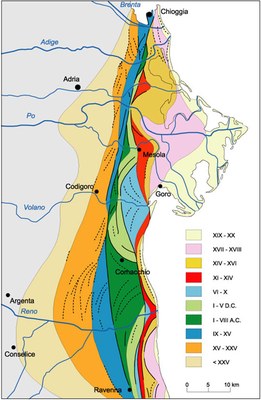 (
(151.65 KB)units and the evolution of the different generation of prograding delta lobes (Fig. 2).
Sequence stratigraphy architecture of transgressive-regressive deltaic units, outcropping, or buried in the shallow subsurface (Fig. 3, 4) and the impact of the eustatic fluctuations. Stratigraphy influence on the fast subsidence impacting on the difficult pumping station management. Relationship between the depositional architecture of the Po river natural levee body and the urban structure. Recent artificial embankment work aimed at mitigating the impact of the high tides on the town, a flooding danger largely increased by the fast subsidence evolution.
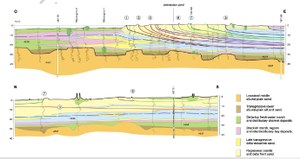 ( ( |
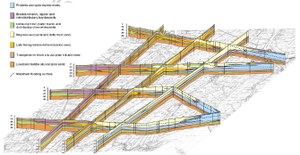 ( ( |
(2) Bronze Age aeolian sand deposits at Ponte Maodino and the hydrogeology implications.
Aeolian sand bodies deposited at about 3000 yr B.P. and their relationships with brackish marsh sediments. The impact of the depositional architecture on the hydrogeological behavior of the area, the local subsidence evolution, and the failure of a large gravity-driven land reclamation attempt performed during the second half of the XVI century. The important of fresh water artificial input into the phreatic aquifer to prevent salinization.
Bus transfer through the delta top sand plain area, crossing many coastline ridges, developed through the last 3000 yr.
(3) Depositional evolution and present-day environmental features of a coastal bay and sand spit: the Sacca di Goro.
The fast progradation of the modern Po Delta, over more than 25 km, induced by an artificial canal cut (1604 a.D.), and the growth of its southern distributary channel (Po di Goro, Fig. 5). The influence of palaeoclimate fluctuations and subsidence evolution on the depositional dynamics of the delta. Boat excursion into the shallow water bay (Sacca di Goro, Fig. 6), subject to episodes of severe eutrophication ad disoxia, affecting the important pelecypod production. Relationships between the delta distributary channel levee and the bay mud sediments (Fig. 7). The fast growth and erosive crisis of a modern sand spit, related to the Po di Goro mouth, and the ongoing transgression of former coastal wood areas (Fig. 8). Discussion on the ecological evolution of the foraminifer assemblages through Holocene times and the recent dramatic increase of deformed tests percentages, related to the bay pollution (Prof. Valeria Luciani). Lunch on the spit beach of at the lighthouse.
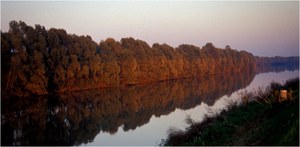 ( ( |
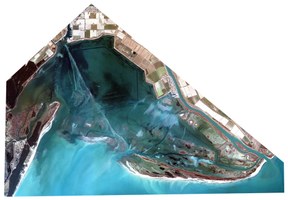 ( ( |
|
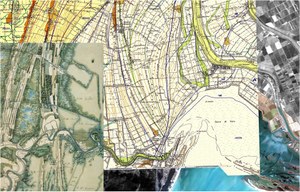 ( ( |
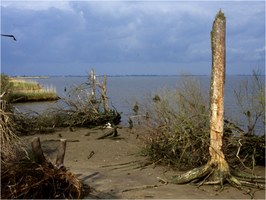 ( ( |
(4) Fossil aeolian dunes of late Bronze Age (Italba-Massenzatica).
Walk through the largest dune field of the Adriatic coast (Fig. 9, 10), developed at about 3000 yr b.p., during a phase of sharp climate change toward strongly windy and arid conditions. Well preserved aeolian morphologies and the role of NE and SE winds. The hydrogeological behavior or the permeable aquifer. The development of a Roman times road (Via Popilia) on the landward side of the sand body, and its regional correlation. The historic importance of the area for wine production and the selection of well adapted vine “cépage”. The nature conservation effort and the excessive overgrowth of poplar woods. The role of the area as a portion of the regional natural park of the Po Delta.
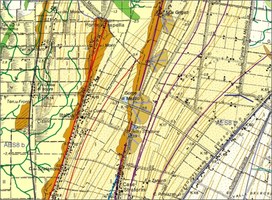 ( ( |
 ( ( |
Excursion ending and bus return to Bologna Fiera, between 6 and 7 p.m.
-
Go to the Po river Delta registration form
